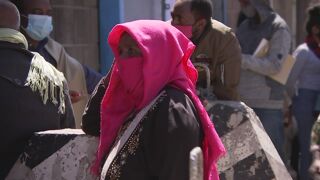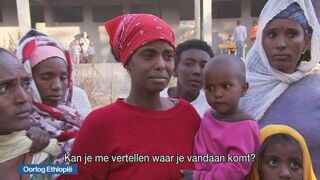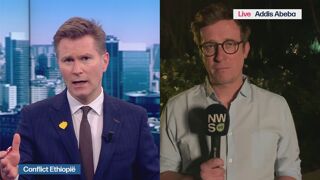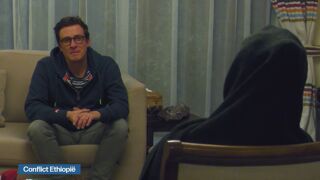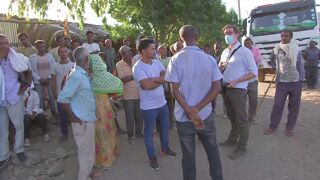Source: Middle East Institute
December 23, 2020
Guled Ahmed
Summary
The Biden Administration is set to face a series of challenges in the Horn of Africa. Given growing Russian and Chinese involvement in this strategically important region, U.S. policymakers should be attuned to the historical background and current dynamics in the relevant countries. In the Horn of Africa, the U.S. can ameliorate the COVID-19 pandemic, stem ongoing civil strife, and ease intraregional tensions. To achieve these objectives, the U.S. will need to adopt bold strategies based on lessons from the past. This article provides essential context about the region and proposes policy measures for the incoming administration.
Contents
1. Introduction
2. The Unfolding “Triple Threat” Humanitarian Crisis
3. Country Profiles from the Horn of Africa
4. The Return of Russia to the Horn of Africa
5. Failing Horn of Africa Integration
6. Where the U.S. and EU Are Getting It Wrong
7. Opportunities for Biden
Introduction
As Joe Biden prepares to take office on Jan. 20, 2021, the U.S. and the world are facing multiple crises. Now is one of the worst times in American history as the country struggles through a major economic recession and a pandemic that has taken more than 300,000 American lives. Biden is no stranger to economic crises, having served as vice president under the Obama administration during the Great Recession in 2009. Undoubtedly, Biden’s experience as a senator and VP makes him ready to tackle America’s domestic challenges and to reset relations with its allies.
In the Horn of Africa, his upcoming administration will grapple with longstanding challenges. However, this time, he will have to deal with the emboldened and unchecked leaders of the Horn of Africa — Prime Minister Abiy Ahmed of Ethiopia, President Mohamed Abdullahi (Farmaajo) of Somalia, and President Isaias Afwerki of Eritrea. Recently, the three leaders have formed an axis through the Horn of Africa Cooperation (HoAC) deal to consolidate security, stability, and economic integration.1
The main driver of the HoAC is PM Abiy, who wants to access Somali ports for trade and promote military and economic integration in order to influence Somali politics and economy. More multilateral agreements and initiatives may come on the heels of the HoAC. In the long term, integration may become possible once the three countries stabilize and resolve their border issues.
In terms of foreign involvement in the region, the Horn of Africa could become a theater for the escalating Cold-War-like dynamic between the U.S and Russia. With its increasing power and influence, Russia could repeat strategies from Syria in the Horn of Africa and help prop up leaders of the Horn of Africa Axis who are desperate to stay in power, regardless of the results of democratic elections. Because the incoming Biden Administration will advance human rights and democratic elections, Horn of Africa leaders may turn to Russia for protection instead.
The Unfolding “Triple Threat” Humanitarian Crisis
The Horn of Africa has suffered multiple disasters since the start of 2020, including the COVID-19 pandemic, recurring deadly floods, and devastating locust attacks. Several donors and humanitarian agencies have increased calls for support to tackle the “triple threat” in the region. Even before the current crises, Somalia, one of the world’s most fragile states, suffered droughts in 2017 that impacted more than 6 million inhabitants. In 2018 and 2019, the Shabelle and the Juba river riparians had already experienced recurring cycles of drought and floods. And now for the first time in recorded history, the Shabelle River, which is Somalia’s breadbasket, is under a locust attack. A swarm of locusts can occupy 460 square miles and consume up to 6,000 metric tons of food daily. The current swarms can inflict the equivalent of more than 120,000 hectares of crop damage within the Shabelle River Basin. Combined with flood damages this year and previous instability, Somalia could experience catastrophic food insecurity and mass starvation similar to the horrific 1974 drought.
In Ethiopia, another full-scale humanitarian crisis is unfolding due to the ongoing civil war between the government and the Tigray People’s Liberation Front (TPLF) in the Tigray region. Locust attacks have also compounded the impact on citizens. The current invasion of desert locusts is the worst that Ethiopia has experienced in 25 years. Furthermore, the COVID-19 pandemic has hurt economic conditions by restricting the agricultural supply chain, productivity, and cross-border trade. On top of these external factors, agriculture export revenue is already negatively impacted by Ethiopia’s currency devaluation. These conditions could push Ethiopia into starvation, mass migration, and multilateral ethnic conflict, and thus threaten overall regional stability.
Country Profiles from the Horn of Africa
The Post-Cold War Horn of Africa is fragile and susceptible to cyclical crises as a result of conflicts and increased climate change. This region also suffers from the legacy of ruthless dictators, such as Mengistu Mariam of Ethiopia and Siad Barre of Somalia. After both dictators were overthrown, new governments adopted systems of fragile ethnic federalism and decentralization that are now destabilizing the region.
Ethiopia
Ever since Abiy was selected as prime minister in April 2018, violence driven by ethnic tensions has gripped Ethiopia and displaced 1.8 million people. Abiy’s vision of a centralized power controlling the political process and economic development appears to be irreconcilable with the ethnic federalism enshrined under Article 39 of the Ethiopian Constitution. While nationalism has kept Ethiopia together for the past 30 years, it has also created division and hostility between Abiy’s reformist government and the TPLF and Oromo opposition leaders who have returned from exile.
With his political reforms intended to promote Ethiopian nationalism failing, he has also hastened economic liberalization through privatization and currency devaluation. The U.S. dollar has appreciated against the Ethiopian birr by more than 35% as the country simultaneously faces a severe export decline, yearly debt payments surpassing $1 billion, and declining domestic borrowing. Overall, this trend has forced Ethiopia to print money at an unsustainable rate. “Abiynomics” will burden Ethiopia with unpayable IMF loans and Chinese loans to finance dam projects. Furthermore, borrowing has increased the debt-to-GDP ratio to over 50%, a rate that is unsustainable, especially for a country that experiences annual major droughts. This rate of borrowing ultimately forced Ethiopia to reschedule 60% of its loan repayment.
To divert public attention from the impending economic crisis and unrest that have tarnished Abiy’s image, he has turned the Grand Ethiopian Renaissance Dam dispute with Egypt and Sudan into a nationalist rallying cry and canceled an agreed-upon deal. Similarly, opposition groups have accused him of taking advantage of the COVID-19 pandemic to unconstitutionally delay the national election, extending his term for almost another year. These actions have incited major opposition, especially from militias in Oromo and Tigray, which threatened to form a caretaker government following Article 60, Section 5 of the Ethiopian Constitution. Abiy took this threat seriously and decided to jail the outspoken Oromo opposition leader Mohamed Jawar. Furthermore, the federal government declared the regional Tigray elections illegal and imposed an economic embargo, which contributed to the civil war. Despite Abiy claiming victory at the end of November, 2020, the war rages on, with thousands displaced and effects that could destabilize the entire region.
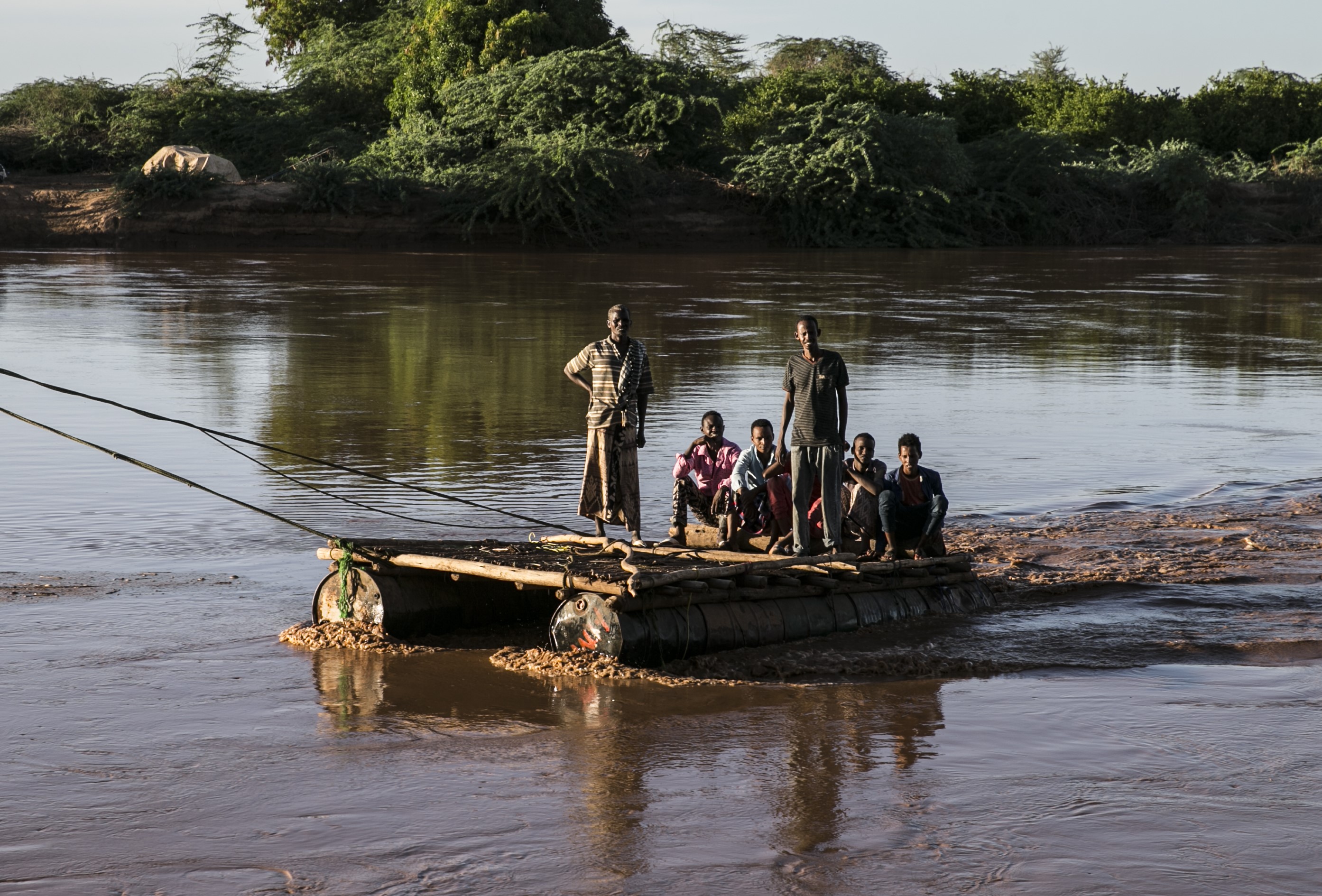 Somalians use a makeshift raft to cross the Juba River to meet their families in Ethiopia. (Cem Genco/Anadolu Agency/Getty Images)
Somalians use a makeshift raft to cross the Juba River to meet their families in Ethiopia. (Cem Genco/Anadolu Agency/Getty Images)
Somalia
In Somalia, Mohamed Abdullahi Farmaajo became president in February 2017 through indirect elections by tribal chiefs. His election was marred by corruption even though he ran on an anti-corruption platform.5 Despite his promises, Somalia has been named the world’s most corrupt country three times in a row by the Corruption Perceptions Index. Furthermore, despite his anti-Ethiopian platform, Farmaajo became President Abiy’s reliable ally during his tenure.6 Abiy even seem to have convinced Farmaajo of the idea of “Greater Horn of Africa Economic Integration.” The two leaders also have similar political preferences. Both are against federalism and for centralized government, despite the weak Federal Government of Somalia (FGS) that only controls parts of the capital with the help of the African Union Mission in Somalia (AMISOM) and the Somalia donors fund. Instead of cooperating with federal member states (FMS), he started dismantling the federal system through electioneering that installed his allies as state leaders. Starting with Southwest State, his forces arrested the likely winner, clearing the path to victory for his hand-picked candidate. This move caused a backlash that was particularly intense in Baidoa, where the Somali National Army along with Ethiopia violently cracked down on protests in December 2018.
In response, UN Somalia Special Representative Nicholas Haysom requested an investigation. Haysom was allegedly expelled so that the Ethiopian Army and Somalia National Army could conceal their crimes and avoid potential prosecution.7 The FGS succeeded in further electioneering by installing their preferred candidate in Galmudug and Hirshabelle states. The FGS was unable to pull off the same feat in Puntland.8 In Jubbaland state, Kenyan AMISOM troops almost clashed with Ethiopian AMISOM troops who are pro-Farmaajo.
Mogadishu, which is in the Benadir region, has become the city with the most internally displaced persons (IDPs) in Africa due to local conflicts. The FGS has paralyzed the city’s economy and mobility, essentially turning it into an open-air prison where IDPs are more than 25% of the population. Not only do the residents of Mogadishu live under difficult circumstances, they also provide taxes to the federal government without enjoying political representation in the Senate. This is because Mogadishu is not recognized as a federal state, which entails less autonomy.
The general condition of Somalia has declined under Farmaajo, The security improvements created by his predecessor, Hassan Sheikh, have vanished. The robust GDP growth of 4% has dropped below 2% and export revenue dropped by 70%, a figure unseen since the 1980s. Foreign direct investment decreased and domestic revenue was below 2016 levels. While not attributable to Farmaajo’s policies, Somalia has also seen a decline in remittances. In an apparent reflection of its corruption, the federal government has camouflaged aid from donors like Qatar as domestic revenue in order to meet debt relief obligations and improve its image abroad.9 Despite Somalia’s lack of financial accountability and illegitimate tax revenue increases, the IMF and World Bank determined that the country has reached the “decision point,” at which heavily indebted poor countries are considered to have met the obligations for interim debt relief. The U.S. has further enabled Farmaajo by supporting debt relief and turning a blind eye on FGS human rights abuses, their war against FMSs, media repression, and deteriorating security. However, the U.S has suspended military aid over corruption concerns.10
As a primary foreign donor to the FGS, Qatar is another important player in the region. Beyond propping up FGS, Qatar has allegedly encouraged violent extremism and instability. A cellphone call obtained by the New York Times captured the Qatari ambassador to Somalia stating that a terrorist bombing in Bosaso was carried out to further Qatari interests.11 Similarly, Somali intelligence chief Fahad Yassin Hajji Dahir, who is alleged to have ties with al-Qaeda, is currently said to be engineering the re-election of Mohamed Abdullahi Farmaajo.12 This major foreign interference could have serious consequences, such as igniting public unrest and possibly even a civil war similar to that in 1991, which overthrew Siad Barre, Farmaajo’s uncle.13
Eritrea
While there are no major violent conflicts in Eritrea, the government shows many of the same pathologies as Ethiopia and Somalia. Although Eritrean President Isaias Afwerki has rehabilitated his image through the historic peace deal with PM Abiy, he remains a ruthless authoritarian who has been starving his people for the past 20 years. With the peace deal, Isaias Afwerki merely showed the EU a false soft side in order to gain aid and assistance. Thus, the EU diplomats are in essence ignoring the regime’s record of human rights violations and forced labor in order to fund projects that will further Europe’s interest in keeping migrants in Eritrea. The EU has funded infrastructure projects serviced by forced conscript labor, perpetuating a system that the U.N. has defined as “tantamount to slavery.”14 Thus, it seems that the EU has chosen to “hire” a dictator at a low price rather than solve the core issues that cause migration in the first place. This is why the EU Horn of Africa policy is failing: it emboldens dictators to oppress their citizens at the expense of EU taxpayers.
Afwerki is widely unpopular, so he is vulnerable to a potential coup. While Afwerki is a brutal dictator, a coup would certainly be destabilizing. In the past, he narrowly escaped previous coup attempts from dissatisfied armed forces, such as in 2013. It is highly likely that he will face another coup because of his alliance with Abiy, who is particularly disliked among the ethnic Tigray in Eritrea.15
“In the 21st century, the EU and the U.S. have pushed for Horn of Africa integration in three key areas: politics, economics, and security. This encouragement is an important reason why Horn of Africa Axis leaders pursued forming a new regional organization bloc. However, these initiatives have been dead on arrival for various reasons.”
The Return of Russia to the Horn of Africa
Russia has been steadily making inroads with the region’s leaders. While hosting the Sochi Olympics in 2017, Russia seized the opportunity to strengthen its relationship with Africa by organizing the 2019 Russia-Africa summit that saw trade, aid, and military deals offered with no political preconditions. Russia’s goal is to project its power and influence in the Horn of Africa and the Red Sea by providing arms and nuclear technology for energy development in exchange for mining natural resources like uranium and gold. Russia is also interested in securing the rights to rare earth elements (REE), which are key ingredients in batteries for electric cars, cell phones, high-tech weapons, and wind turbines. Russia has been steadily accumulating REE to the point where it now has the 4th largest reserves in the world, significantly ahead of the U.S.16
Just outside the Horn of Africa, former Sudanese President Omar al-Bashir signed bilateral agreements with Russian President Vladimir Putin during his November 2017 visit to Russia that included the establishment of a military base in the Red Sea, a nuclear agreement, and modernization of the Sudanese army.17 Similarly, Bashir asked Putin for protection from the U.S.and hired Russian mercenaries to quell citizen uprisings before his overthrow in a military coup.18 It is noteworthy that Bashir’s visit to Russia came after the Trump administration lifted the trade embargo on Sudan and removed it from the travel ban list. This suggests that both the U.S. and Russia are competing for Sudan’s favor.
In the Horn of Africa, Russian Foreign Minister Sergei Lavrov announced the opening of a logistics center in Eritrea in 2018, but gave few details about its purpose.19 The lack of information likely indicates a larger strategic aim. A Russian logistics center in Eritrea, however, now looks improbable due to the Eritrean government’s realignment toward the UAE and Saudi Arabia, two countries that are loathe to see Russian encroachment in the Red Sea. Opposition from these two Gulf countries will be an obstacle to Russia’s quest to gain influence in the Horn of Africa.
The extent of Russia’s influence on Somalia will largely depend on the results of upcoming elections. One of the candidates for the Somali presidency is former Prime Minister Hassan Ali Khaire, who cofounded Som Oil & Gas. For various reasons, Russia is hoping for his victory. The majority stakeholder in Som Oil & Gas is the Russian national Georgy Djapridze, who is also a close ally of Putin. In November of 2020, Khaire met with Foreign Minister Lavrov to discuss the upcoming elections and the prospects for strengthening Russian-Somali cooperation, particularly trade and economic ties. Such a meeting seems to validate suspicions that Khaire is seeking to obtain Russian assistance in the elections. Given Somalia’s instability, if Khaire wins the presidency he may invite Russian mercenaries to restore order.
In November of 2020, Russia and China indicated their support for the Somali government by abstaining on a vote to renew the UN panel of experts on Somalia, which includes an arms embargo.20 Russia justified its abstention by comparing the vote to lifting the Eritrea embargo in 2018, and China reasoned that the embargo hindered the Somali government’s ability to combat al-Shabab. The true intention behind Russia’s abstention was to protect its interest in selling arms to Somalia, however. China, for its part, wanted to maintain a strong relationship with Somalia, especially as it has received an unmonitored and controversial fishing license from the Somali government. China also supports Somalia on the question of Somaliland.21 China sees Somaliland, a de facto independent state, as analogous to Taiwan. Recognition of Somaliland would thus set a precedent that would undermine the “One China” policy.
The U.S. has left an opening for these powers. The inaction and disengagement of the Trump administration allowed Russia to preemptively protect the region’s new authoritarians. In contrast, the upcoming Biden-Harris administration will likely hold the Horn of Africa Axis accountable for human rights violations and their destabilizing anti-democratic ways. Russia may be a latecomer to the 21st century version of the “Scramble for the Horn of Africa” but won’t mind claiming its spot as a competitor against China’s Belt and Road Initiative and the EU’s initiatives in the Horn of Africa.
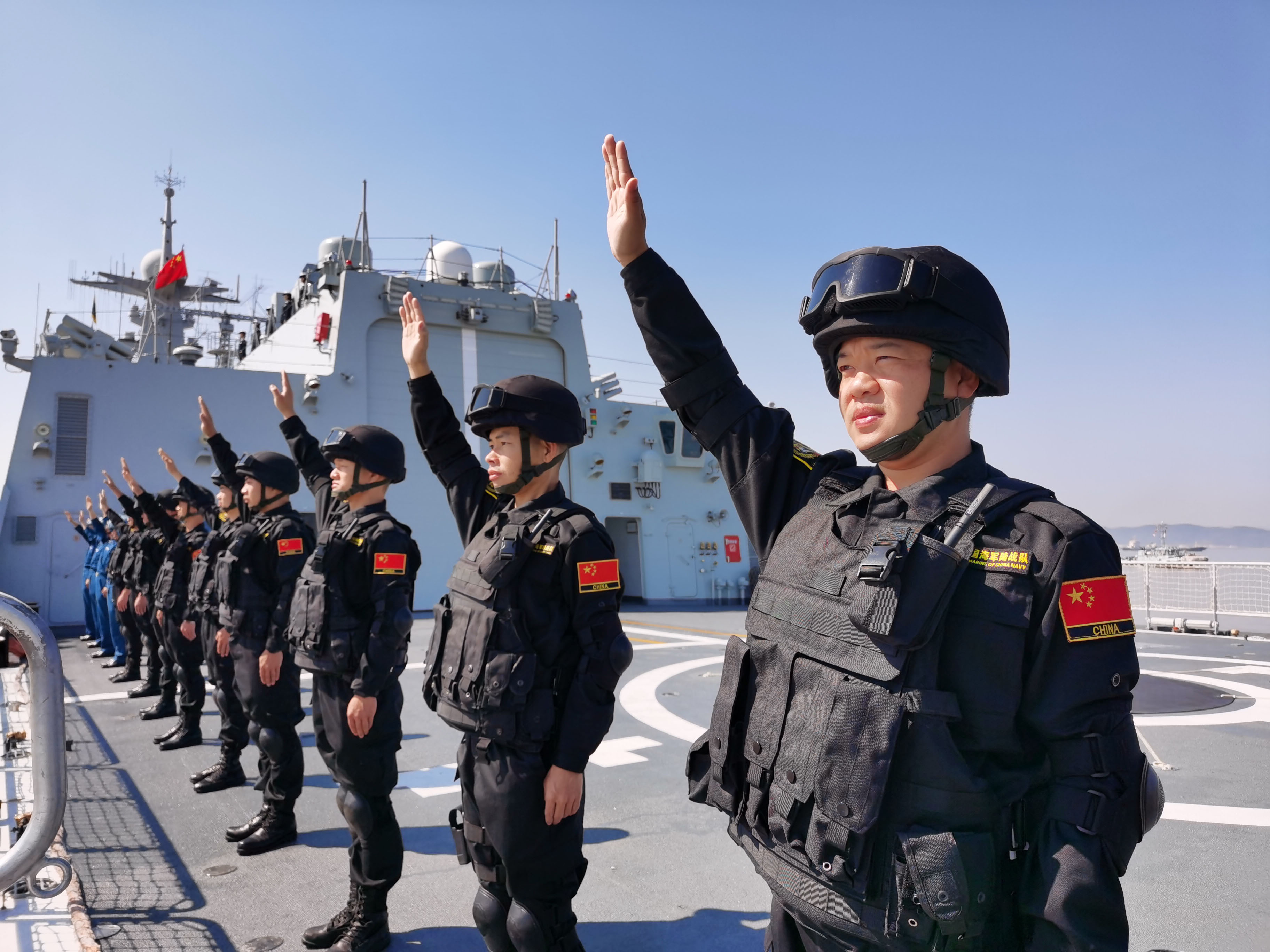 Chinese special operations soldiers wave farewell as they depart from a port in Zhoushan and head toward the Gulf of Aden to patrol waters off the coast of Somalia.(Xinhua/Jiang Shan via Getty Images)
Chinese special operations soldiers wave farewell as they depart from a port in Zhoushan and head toward the Gulf of Aden to patrol waters off the coast of Somalia.(Xinhua/Jiang Shan via Getty Images)
Failing Horn of Africa Integration
The idea of integrating the various territories of the Horn of Africa has a long history. Current Horn of Africa integration initiatives echo the idea of “Greater Somalia.” This concept was championed by Benito Mussolini, who hoped to capture British-Somaliland, part of Ethiopia, and Italian Somalia to achieve the grandiose idea of an Italian East Africa empire. Mussolini imagined Italians settling in the territory. He also wanted to connect Assab (a port city in Eritrea) to Mogadishu in order to reduce the export cost of cotton, bananas, and other valuable commodities. In post-colonial times, this vision of integration has been revived and modified. Fidel Castro, for example, proposed a communist federation between Ethiopia and Somalia before the two countries went to war in 1977.
In the 21st century, the EU and the U.S. have pushed for Horn of Africa integration in three key areas: politics, economics, and security. This encouragement is an important reason why Horn of Africa Axis leaders pursued forming a new regional organization bloc. However, these initiatives have been dead on arrival for various reasons.
Events show that the region is disintegrated from a military and political point of view. To give a stark example of regional strife, the Ethiopian army committed war crimes in Somalia in 2006. Ethiopian forces have also not produced tangible results in the war against al-Shabab as a part of the AMISOM force. For its part, the Eritrean government is a former funder of the terrorist group al-Shabab, which has wreaked havoc in Somalia.
Destabilizing actions by Ethiopia and Eritrea in Somalia have precluded political integration. As a former Somali president said, “Simply put, neither Ethiopia nor Somalia is ready for deeper integration. Ethiopia is sliding toward instability and preoccupied with both internal ethnic conflicts and border disputes with Somalia and Eritrea.”22
From an economic point of view, the countries of the Horn of Africa have negligible engagement. This is the case for Eritrea and Somalia. As for Somalia and Ethiopia, several economic barriers currently stand between them. Ethiopia is foreclosing on Somalia’s future water rights by building more dams without consultation, which negatively impacts the Juba and Shabelle rivers. The two countries also do not have a transboundary water agreement, and Ethiopia is notorious for not sharing its river flow data. Already, these actions have contributed to recent floods and droughts according to regional water experts. While cross-border electrification initiatives are pushed by the World Bank and foreign donors to Somalia, they come with high risks such a lack of institutional oversight, infrastructural unpreparedness, and energy security politicization. Furthermore, the two countries have economies that are largely informal and affected by multiple problems such as high inflation, lack of security, indebtedness, high unemployment, and poor infrastructure with limited interconnectedness.
“Without decisive and sustainable policy moves, geopolitical dynamics in the Horn of Africa could sow the seeds for further turmoil within the next 20 years.”
Where the U.S. and EU Are Getting It Wrong
The U.S. has promoted misguided policy in the Horn of Africa region. For example, it supported an Ethiopian incursion into Somalia that resulted in war crimes against residents of Mogadishu in 2006.23 To date, victims have not been awarded any compensation and justice has not been served. In 2010, while speaking at the Humphrey Institute of Public Affairs, current U.S. ambassador to Somalia and former ambassador to Ethiopia(2006-2009), Donald Yamamoto said, “We’ve made a lot of mistakes and Ethiopia’s entry in 2006 was not a really good idea.”
Ambassador Yamamoto would do well to recognize that China poses a threat to U.S. interests in Somalia and to the region as a whole. One way that the U.S. could counter Chinese designs on Somalia is by encouraging the ties between Taiwan and Somaliland. So far, Yamamoto has remained silent about this bilateral relationship even though the U.S National Security Council sent out a congratulatory tweet about this emerging bond between Taiwan and Somaliland. U.S. inaction has emboldened President Farmaajo to align with Beijing.
EU policy toward the Horn of Africa has also yielded mixed results. It is wholly fixated on keeping migrants away from EU shores, making the region a hub for IDPs. The significant presence of IDPs tends to spur conflict. Africa watchers have argued that EU funding without proper checks and balances merely finances kleptocratic authoritarians. This model has already been tested with Turkey in order to keep Syrian refugees outside Europe. A negative consequence of this policy was to give Turkish President Recep Tayyip Erdogan leverage over the EU. While EU leaders claim to want stability for the Horn of Africa, they continue sell arms to the region. In Germany, Chancellor Angela Merkel is pushing arms sales to the region and the continent to counter Russia and China.24 Similarly, French President Emmanuel Macron is helping Abiy develop a navy, despite Ethiopia being landlocked.25
The EU approach to migration, cyclical conflicts, and the impacts of climate change in the Horn of Africa is not working. Rather than throw money at problems, the EU must seek to cultivate good governance and institutions. Perhaps it is time to support an approach to sustainable development that takes power away from dictators and puts it in the hands of local actors. Current strategies have only resulted in mass migration and vulnerable youth who can easily be recruited by extremists. It is not surprising to see recurrent cycles of destruction and humanitarian crises in the region.
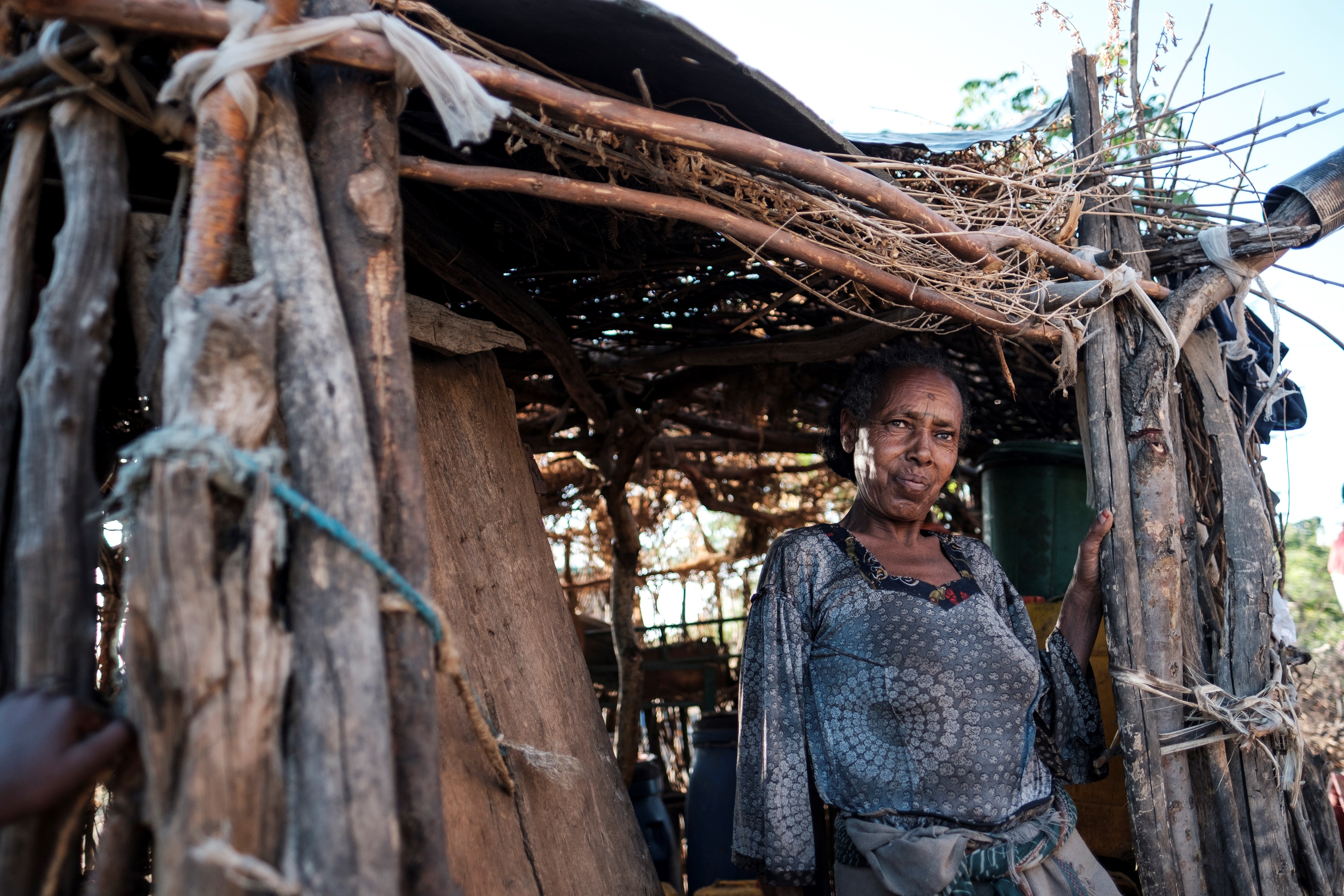 A woman whose son was reportedly killed by Ethiopian Defense Forces poses in front of her house in Bisober, a farming village in southern Tigray. (Eduardo Soteras/AFP via Getty Images)
A woman whose son was reportedly killed by Ethiopian Defense Forces poses in front of her house in Bisober, a farming village in southern Tigray. (Eduardo Soteras/AFP via Getty Images)
Opportunities for Biden
How can the Horn of Africa become peaceful and secure despite high levels of instability, mistrust, and unresolved border issues inherited from colonial times? With the rise of authoritarianism, repressive rule, terrorism, ethnic cleansing, nationalism, economic stagnation, and mass migration, this goal seems to be moving further away. Without decisive and sustainable policy moves, geopolitical dynamics in the Horn of Africa could sow the seeds for further turmoil within the next 20 years. What should the Biden administration do?
- China Vaccine Politics: The Pfizer COVID-19 vaccine must be stored at -70 degrees Celsius, which will require costly refrigeration for safe distribution. Unfortunately, almost 40% of the healthcare facilities in Africa don’t have access to electricity, and only 28% of them have reliable electricity. China is speeding up distribution to Africa of its own vaccine, which requires storage at 2 to 8 degrees Celsius. Africa, due to its climate and level of development, may not be able to meet the refrigeration demands for either vaccine. This opens an opportunity for Biden to accelerate vaccine delivery and distribution through humanitarian channels, i.e. USAID and Direct Relief, and through investment channels or public-private partnerships, i.e. the International Development Finance Corporation.
- AMISOM in Somalia: Recently the Ethiopian government redeployed 3,000 of its troops from Somalia to the civil war with TPFL.26 The Ethiopian troops in Somalia were ineffective in fighting al-Shabab terrorists, and most of its troops were supporting the government of Somalia to wage war against FMS. The recent U.S. troop pullout under Trump is also likely to embolden al-Shabab to capture more territories. Troops should remain in Somalia, but they should be UN peacekeepers with a five-year mandate rather than ineffective AMISOM troops. Due to their vested interests, countries like Kenya and Ethiopia should be excluded from any peacekeeping mission in Somalia
- U.S. Horn of Africa Special Representative: Biden should consider appointing a special representative to oversee security and development in this increasingly important region. The representative’s mandate should also include the Red Sea. This position will help the State Department to better engage regional leaders and allies. Such engagement will help the U.S. to counter the aggressive expansion of Russian and Chinese interest in the region.
- Reform Trade: The African Growth and Opportunity Act (AGOA) has significantly reduced the continent’s trade deficit with the U.S. to less than $5 billion.27 However, U.S. imports from Sub-Saharan African countries are concentrated in apparel and oil products.28 The Biden administration could increase non-oil exports from the region to the U.S. by prioritizing agro-manufacturing and fish processing industries, setting up more export zones, repealing all Trump tariffs against products that are produced in Africa, and adding new countries to the AGOA, such as Somalia and Eritrea.
- War Against al-Shabab: The current government of Somalia has focused on waging war against FMS and instigating clan wars rather than fighting against al-Shabab. The Biden administration should hold Somalia accountable for its failures on human right and counterinsurgency. The administration must adopt diplomatic and economic strategies rather than drones. Furthermore, Biden could consider investing in and providing U.S. army training to local militia and Danab forces. They are more effective than the national army, which is hampered by weak federal institutions.29 Similarly, the Biden administration should invest in a strong finance tracking system and biometric registration, not only to track illegal activities, but also to build a voter registration system and promote democratic elections.
America can no longer sit on the sidelines and allow Russia and China to influence regional leaders, who have become addicted to Chinese predatory loans and Russian AK-47 diplomacy. Biden should implement a strategy that is designed by regional planners and economists, one that is based on strong, democratic institutions with the principle of “one person, one vote” and focuses on capacity building and tangible economic development.
Biden has a difficult task ahead if he is going to de-escalate tensions in the Horn of Africa. His administration has a chance to rectify the mistakes of American presidents over the past half century, who too often turned a blind eye to the destabilizing actions of dictators in the region. It is now or never, and as John F. Kennedy said, “Those who make peaceful revolution impossible will make violent revolution inevitable.”
Endnotes
[1] Henneberg, Ingo and Stapel, Sören. “Cooperation and Conflict at the Horn of Africa: A New Regional Bloc Between Ethiopia, Eritrea, and Somalia and Its Consequences for Eastern Africa,” Africa Spectrum, (August 2020). https://doi.org/10.1177/0002039720936689.
[2] Nyabiage, Jevans. “China’s Allies at Loggerheads Over Ethiopia Dam — Will Beijing Intervene?” South China Morning Post, July 26, 2020, https://www.scmp.com/news/china/diplomacy/article/3094650/chinas-allies-loggerheads-over-ethiopia-dam-will-beijing.
[3] Atoma, Bekele. “Jawar Mohammed: The Ethiopian Media Mogul Taking on Abiy Ahmed,” BBC News, July 9, 2020, https://www.bbc.com/news/world-africa-53306091.
[4] Elbagir, Nima, Arvanitidis, Barbara, and McSweeney, Eoin. “Forces From Ethiopia’s Tigray Region say Eritrean Troops are Part of the Conflict and the War is Far From Over,” CNN, December 4, 2020, https://www.cnn.com/2020/12/04/africa/ethiopia-war-tplf-exclusive-intl/index.html.
[5] Gettleman, Jeffrey, “Fueled by Bribes, Somalia’s Election Seen as Milestone of Corruption,” The New York Times, February 7, 2017, https://www.nytimes.com/2017/02/07/world/africa/somalia-election-corruption.html.
[6] “Corruption Perceptions Index,” Transparency International, https://www.transparency.org/en/cpi/2019.
[7] “UN Special Representative to Somalia and Head of UNSOM is “Persona Non Grata” – Somalia’s Foreign Ministry,” Somaliland Chronicle, January 1, 2019, https://somalilandchronicle.com/2019/01/01/un-special-representative-to-somalia-and-head-of-unsom-is-persona-non-grata-somalias-foreign-ministry/.
[8] Hassan, Abdiqani. “Leader of Somalia’s Jubbaland, at Odds With Mogadishu, Wins New Term,” Reuters, August 22, 2019, https://www.reuters.com/article/us-somalia-politics/president-of-somali-state-of-jubbaland-re-elected-in-divisive-vote-idUSKCN1VC15B?il=0.
[9] Gundel, Joakim. Debt Relief and the Political Marketplace in Somalia. London: London School of Economics Conflict Research Programme, November 2, 2020, http://eprints.lse.ac.uk/107125/1/CRP_debt_relief_and_political_marketplace_somalia.pdf.
[10] Rubin, Michael. “U.S. Ambassador Wasted $1B in Somalia and is Now Funding a Coup,” The Washington Examiner, February 7, 2020, https://www.washingtonexaminer.com/opinion/us-ambassador-wasted-1b-in-somalia-and-is-now-funding-a-coup; “Somalia: Journalists Under Attack,” Human Rights Watch, May 3, 2016, https://www.hrw.org/news/2016/05/03/somalia-journalists-under-attack#; Houreld, Katharine. “Exclusive: U.S. Suspends Aid to Somalia’s Battered Military Over Graft,” Reuters, December 14, 2017, https://www.reuters.com/article/us-somalia-military-exclusive/exclusive-u-s-suspends-aid-to-somalias-battered-military-over-graft-idUSKBN1E81XF.
[11] Bergman, Ronen and Kirkpatrick, David D. “With Guns, Cash, and Terrorism, Gulf States Vie for Power in Somalia,” The New York Times, July 22, 2019, https://www.nytimes.com/2019/07/22/world/africa/somalia-qatar-uae.html.
[12] Rubin, Michael. “Somalia’s Intelligence Chief Worked With an al Qaeda Affiliate, so Why Do We Fund Him?” American Enterprise Institute, November 16, 2020, https://www.aei.org/op-eds/somalias-intelligence-chief-worked-with-an-al-qaeda-affiliate-so-why-do-we-fund-him/; Ali, Abdullahi Mohamed. “Somalia Must Save Itself From Qatar,” The National Interest, June 22, 2020, https://nationalinterest.org/feature/somalia-must-save-itself-qatar-163233.
[13] Henry, Neil. “Rebels Force Somali Leader Out of Capital,” The Washington Post, January 1, 1991, https://www.washingtonpost.com/archive/politics/1991/01/01/rebels-force-somali-leader-out-of-capital/7e7267ef-139c-4108-bf67-73687a26a243/.
[14] Stevis-Gridneff, Matina. “How Forced Labor in Eritrea is Linked to EU-Funded Projects,” The New York Times, January 8, 2020, https://www.nytimes.com/2020/01/08/world/europe/conscription-eritrea-eu.html.
[15] Gettleman, Jeffrey. “Coup Attempt by Rebel Soldiers is Said to Fail in Eritrea,” The New York Times, January 21, 2013, https://www.nytimes.com/2013/01/22/world/africa/coup-attempt-fails-in-eritrea.html.
[16] “How is Russia Developing Rare Earth Metals?” Mining World Russia, March 3, 2020, https://miningworld.ru/Articles/how-is-russia-developing-rare-earth-metals#:~:text=As%20of%20June%202019%2C%20Russia,and%201.4m%20tons%20respectively.
[17] “Russia to Establish Military Base in Sudan,” Middle East Monitor, November 13, 2020, https://www.middleeastmonitor.com/20201113-russia-to-establish-military-base-in-sudan/.
[18] “Sudan’s President Bashir Asks Putin for ‘Protection’ From ‘Aggressive U.S.’” France 24, November 23, 2017, https://www.france24.com/en/20171123-sudan-president-bashir-asks-putin-protection-aggressive-us.
[19] Solomon, Salem. “Russia-Eritrea Relations Grow With Planned Logistics Center,” Voice of America, September 2, 2018, https://www.voanews.com/africa/russia-eritrea-relations-grow-planned-logistics-center.
[20] “Adopting Resolution 2551 (2020) by 13 Votes in Favour, 2 Abstentions, Security Council Extends Mandate for Expert Panel on Somalia, Renews Partial Lifting of Arms Embargo,” United Nations Security Council, November 12, 2020, https://www.un.org/press/en/2020/sc14355.doc.htm.
[21] “Report: Somali Fishermen Object to ‘Shocking’ Deal Allowing China in Their Waters,” Stop Illegal Fishing, February 8, 2019, https://stopillegalfishing.com/press-links/report-somali-fishermen-object-to-shocking-deal-allowing-china-in-their-waters/.
[22] Mohamud, Hassan Sheikh. “Somalia Must Learn to Stand Alone,” Foreign Affairs, November 25, 2020, https://www.foreignaffairs.com/articles/africa/2020-11-25/somalia-must-learn-stand-alone.
[23] “Somalia: War Crimes in Mogadishu,” Human Rights Watch, August 13, 2007, https://www.hrw.org/news/2007/08/13/somalia-war-crimes-mogadishu
[24] “Ethiopian Invasion of Somalia, a Debacle U.S. Official Says,” ECADF Ethiopian News, March 13, 2010, https://ecadforum.com/blog1/ethiopian-invasion-of-somalia-a-debacle-u-s-official-says/.
[25] Shelton, Jon. “Angela Merkel Calls for Weapons Exports to Africa,” DW, November 27, 2019, https://www.dw.com/en/angela-merkel-calls-for-weapons-exports-to-africa/a-51441421.
[26] Irish, John. “Ethiopia, France Sign Military, Navy Deal, Turn ‘New Page’ in Ties,” Reuters, March 12, 2019, https://www.reuters.com/article/us-ethiopia-france/ethiopia-france-sign-military-navy-deal-turn-new-page-in-ties-idUSKBN1QT2W3.
[27] Marks, Simon. “Ethiopia Withdraws Thousands of Troops From Neighboring Somalia,” Bloomberg, November 13, 2020, https://www.bloomberg.com/news/articles/2020-11-13/ethiopia-withdraws-thousands-of-troops-from-neighboring-somalia.
[28] Grane, Allen. “What is the African Growth and Opportunity Act?” Council on Foreign Relations Africa in Transition, February 17, 2017, https://www.cfr.org/blog/what-african-growth-and-opportunity-act.
[29] U.S. Trade and Investment with Sub-Saharan Africa: Recent Trends and New Developments. Washington D.C.: U.S. International Trade Commission, March 2020, https://agoa.info/images/documents/15766/pub5043-usitc-report.pdf.
[30] Robinson, Colin D. and Matisek, Jahara. “Assistance to Locally Appropriate Military Forces in Southern Somalia,” The RUSI Journal 165, no. 4 (December 8, 2020), https://www.tandfonline.com/doi/abs/10.1080/03071847.2020.1830711?journalCode=rusi20&.
Additional Photographs
1. Cover Photo: A boy runs with a balloon in the village of Bisober in southern Tigray. (Eduardo Soteras/AFP via Getty Images)
2. Contents Photo: Ethiopian Prime Minister Abiy Ahmed addresses a crowd in Bonga, the main city in Kuffa province, on September 15, 2019. Members of the Kafficho ethnic group have been calling for the formation of their own federal state. Ethiopia’s southern region includes multiple ethnic groups hoping to obtain independent states. (Michael Teweled/AFP via Getty Images)
About the Author
Guled Ahmed has more than 15 years’ experience in hydropower, water resources management, and highways infrastructure projects in developing and developed countries. His water resources experience includes drainage and storm water management design, green and sustainable infrastructure planning, H&H modeling of floodplains, bridges and culverts, and GIS-based watershed assessments and planning. Guled has also been incredibly involved as an advocate on Horn of Africa (HoA) water transboundary treaties, cross-border energy and water security, climate change, and Paris Agreement reforms. As an entrepreneur he has founded two renewable energy companies, Power OffGrid and Jiko Biogas, in Somalia. He has developed disruptive, innovative, and affordable smart hybrid renewable energy and asset financing systems, increasing access to electricity, adequate clean water, and clean cooking, improving productivity in sectors in rural and urban areas in Somalia. He is also certified as a Global Juror of SDG11.
![A Sudanese military personnel seen in Khartoum, Sudan on July 21, 2020 [Mahmoud Hjaj / Anadolu Agency]](https://i1.wp.com/www.middleeastmonitor.com/wp-content/uploads/2020/07/20200721_2_43552309_56880166-1200x800.jpg?resize=840%2C560&ssl=1)



 Somalians use a makeshift raft to cross the Juba River to meet their families in Ethiopia. (Cem Genco/Anadolu Agency/Getty Images)
Somalians use a makeshift raft to cross the Juba River to meet their families in Ethiopia. (Cem Genco/Anadolu Agency/Getty Images) Chinese special operations soldiers wave farewell as they depart from a port in Zhoushan and head toward the Gulf of Aden to patrol waters off the coast of Somalia.(Xinhua/Jiang Shan via Getty Images)
Chinese special operations soldiers wave farewell as they depart from a port in Zhoushan and head toward the Gulf of Aden to patrol waters off the coast of Somalia.(Xinhua/Jiang Shan via Getty Images) A woman whose son was reportedly killed by Ethiopian Defense Forces poses in front of her house in Bisober, a farming village in southern Tigray. (Eduardo Soteras/AFP via Getty Images)
A woman whose son was reportedly killed by Ethiopian Defense Forces poses in front of her house in Bisober, a farming village in southern Tigray. (Eduardo Soteras/AFP via Getty Images)
 SudanTribune December 23, 2020 (GADAREF) - The Sudanese army came under a new attack from Ethiopian army and Amhara militias near the border strip, military sources told the Sudan Tribune on Wednesday.
SudanTribune December 23, 2020 (GADAREF) - The Sudanese army came under a new attack from Ethiopian army and Amhara militias near the border strip, military sources told the Sudan Tribune on Wednesday.


